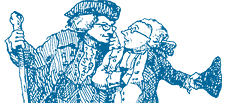The neoclassical dictum that art ought to represent reality is obviously something of a dead letter when reality itself loses its shape and its hitherto clear outlines before our eyes and becomes clouded by ideology. Reality to Marx meant something quite different from what it was to his philosophical predecessors (". . . the point, however, is to change it"), and the ideologues of the various -isms which have since followed the Marxist lead have continued to repudiate any attempt to represent reality in favor of correcting it. This propagandistic purpose has a baneful enough effect on original attempts at art, though we might grant that it is fair enough for those — assuming there are those — with a taste for such things. But applied to existing works, it has a fundamentally falsifying effect that ought to be troubling to anyone with a residual respect for the truth independently of its ideological utility.
Just look at this description, from the U.K. Independent, of a reworking by one Ella Hickson, a playwright, of the Peter Pan story for the Royal Shakespeare Company:
Forget Wendy the happy homemaker, demurely prepared to be mother while the Lost Boys get to be eternally, irresponsibly youthful, or Wendy the damsel in distress, waiting for the plucky boy to save her: Hickson’s Wendy is multi- dimensional, allowed to play house, but perfectly capable of fighting her own battles too. "I am Wendy Darling, I am brave and I am strong and I am going on an adventure!" is both her "happy thought" and her rallying cry. . .Wendy and Peter Pan is set to be a swashbuckling adventure, where girls get to spar with pirates rather than be rescued from walking the plank. And there’s a terrific scene which will have you mentally punching the air, as Wendy, Tink and Tiger Lily — a frankly badass trio — ditch the sneering jealousy to pal up and "kick some pirate bum". Tink, rather than being a trembling Disney waif, is a "Big Fat Gypsy Tink" and stomps around mardily in hi-tops, while the Native American princess Tiger Lily is more Hunger Games, with sturdy boots and a bow. Not that the play is fully modernised: it’s set in 1908, a date between the publication of the original play and the novel. But it was also a significant year for women’s rights — mass protests in Hyde Park attracted crowds of an estimated 300,000 — and indeed, even Mrs Darling gets a radical make-over in Hickson’s version, becoming a suffragette.
We get why she is doing this, of course, but oughtn’t it to matter that she is also attacking J.M. Barrie and the whole concept behind the various incarnations of Peter Pan, which was utterly at odds with the feminist conception? Wendy’s centrality to the story was brought out beautifully in P.J. Hogan’s marvelous film version of Peter Pan of 2003 but, as that version made clear, Wendy was for Barrie the reality principle forming a necessary borderline of his fantasy. She was the reason why the Lost Boys and the would-be Lost Boys had to call a halt to their truancy in Neverland, to abandon Peter Pan and, in the end, to grow up. By making her (along with Tinkerbell and Tiger Lily) just another one of the boys, Ms Hickson has not only taken away her reason for being, she has made a point of denying the truth that Barrie was at some pains to insist upon, namely that the fantasy had to have some boundary, some moment at which it gives way to reality. But then, as I began by saying, ideology is by its very nature in the business of substituting fantasy for reality — including the fantasy that girls are in no important respect different from boys.

